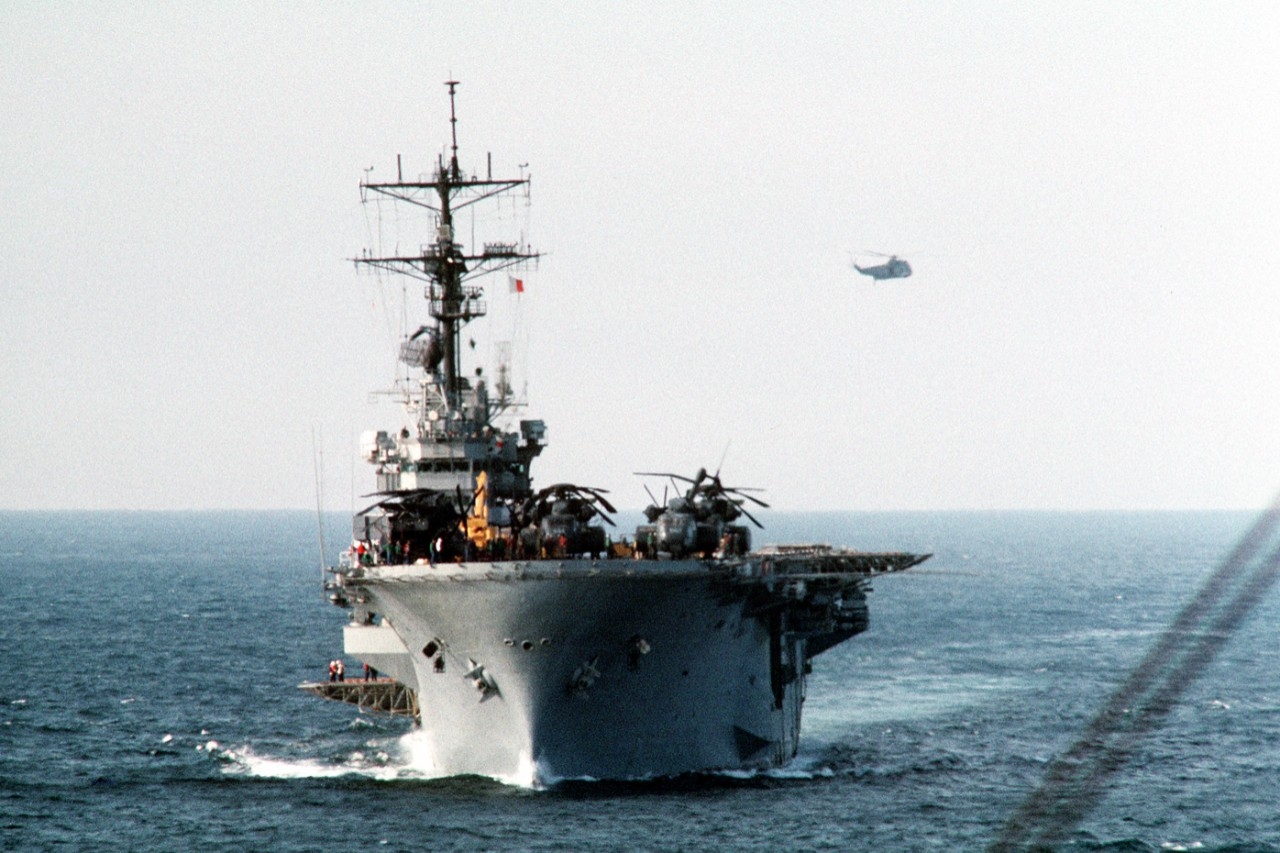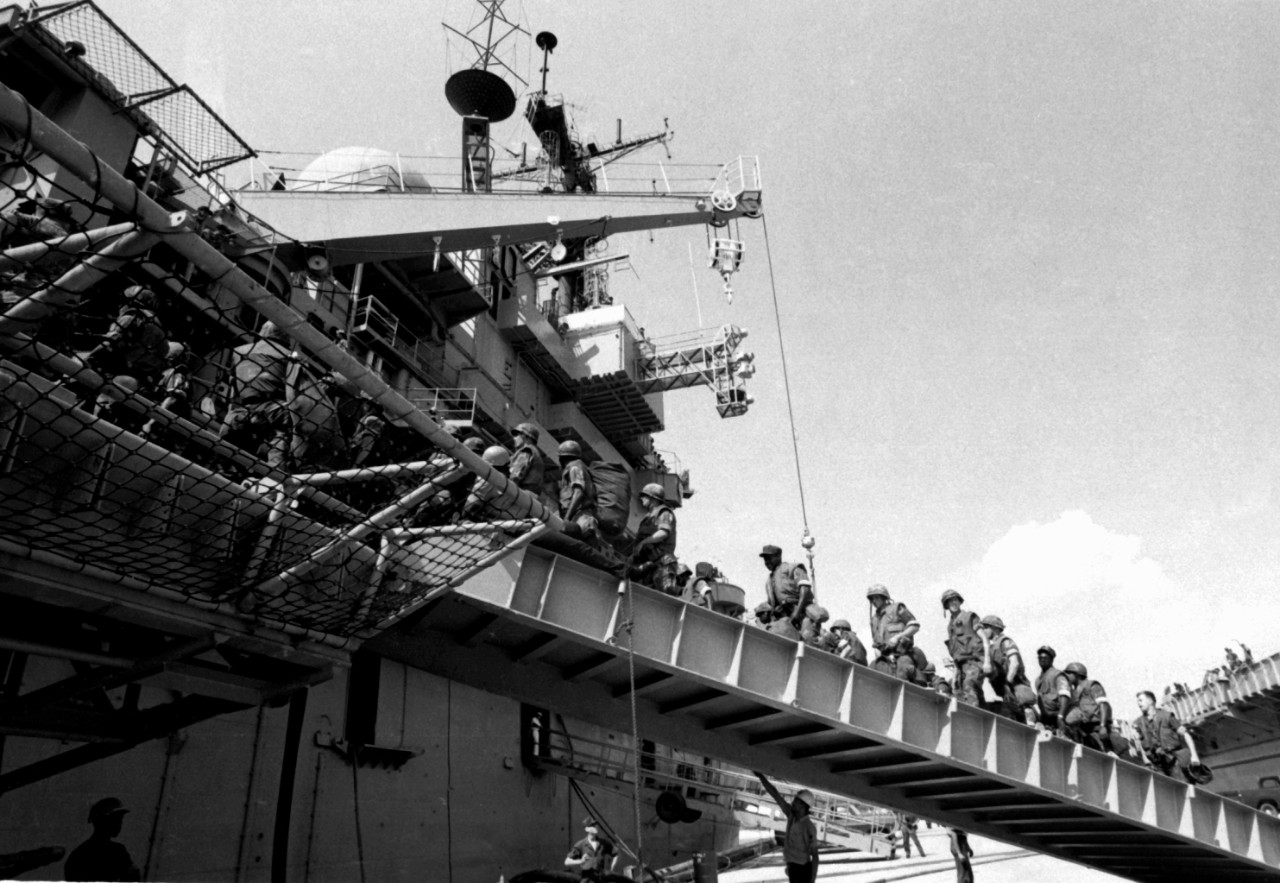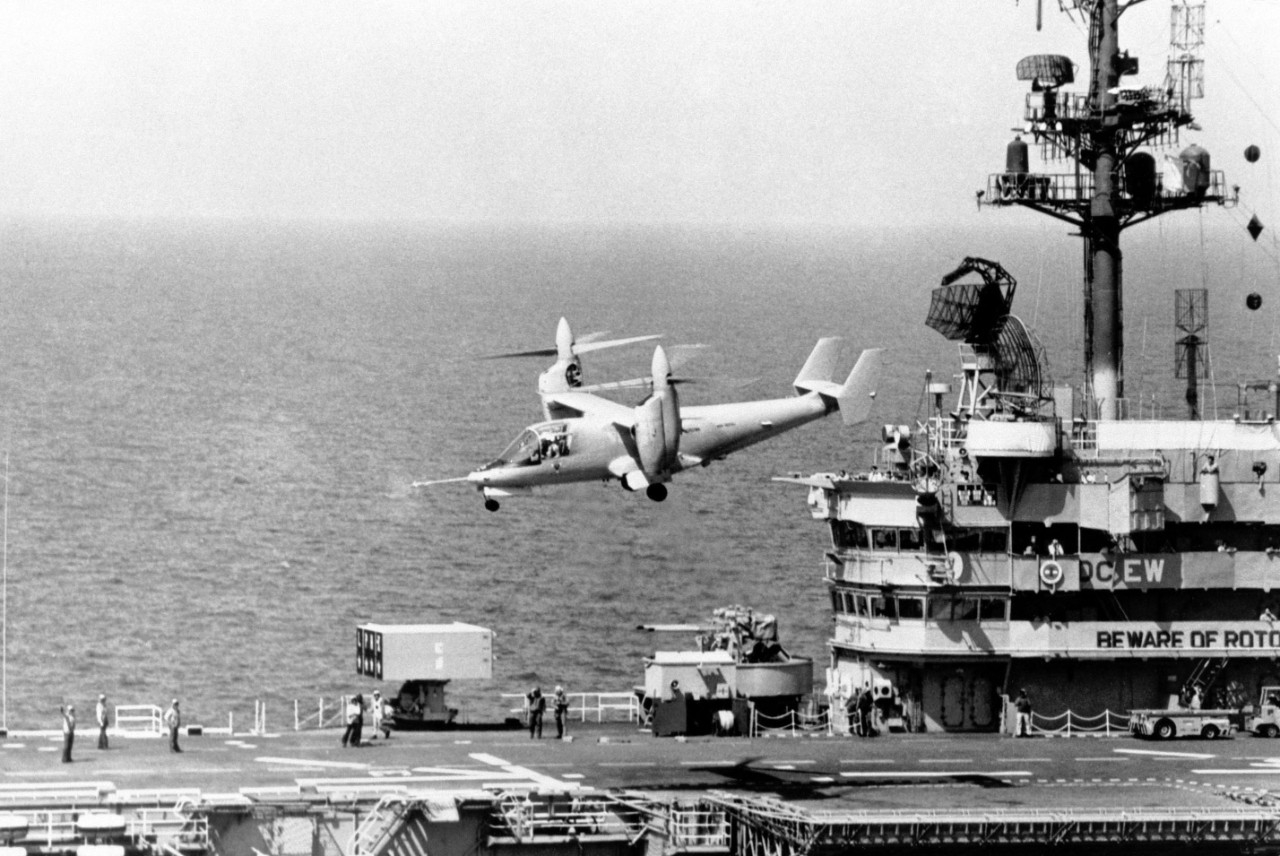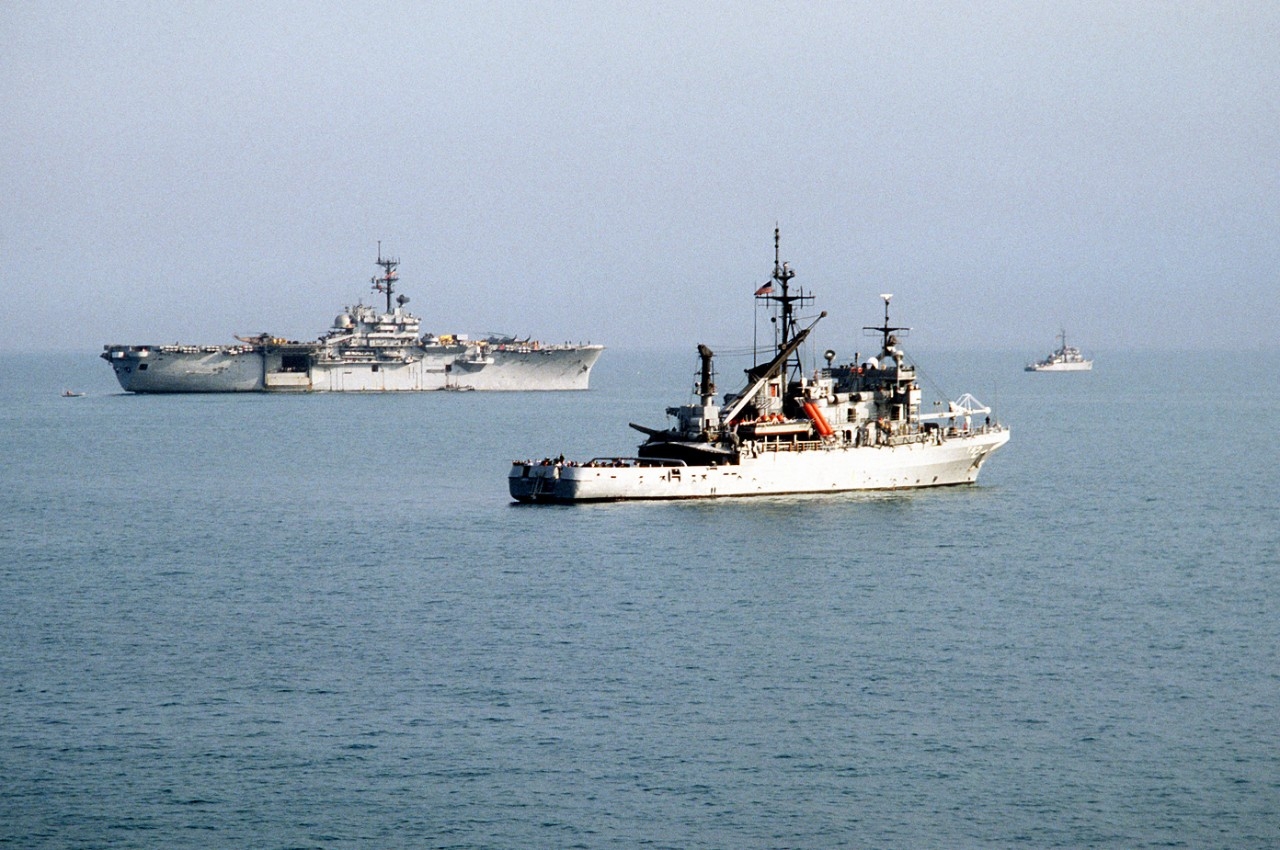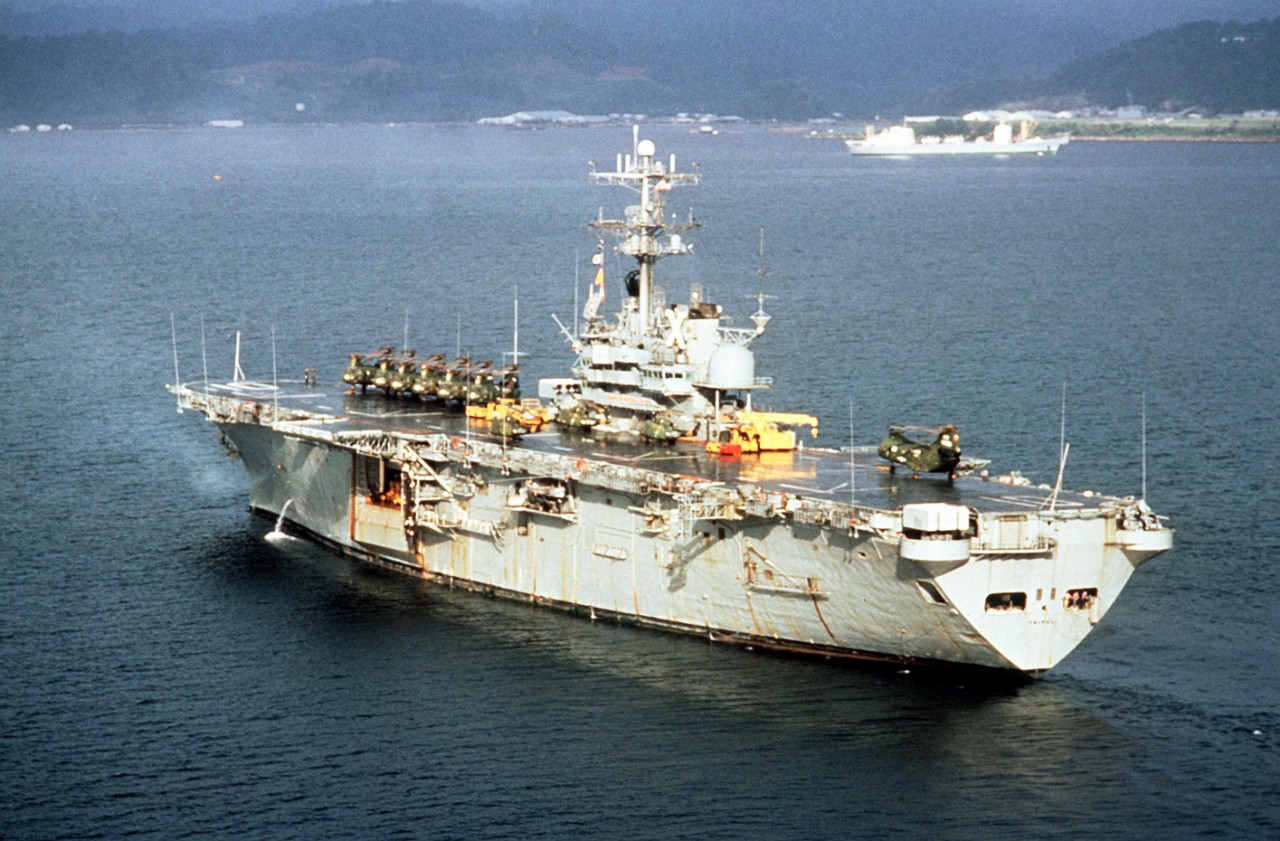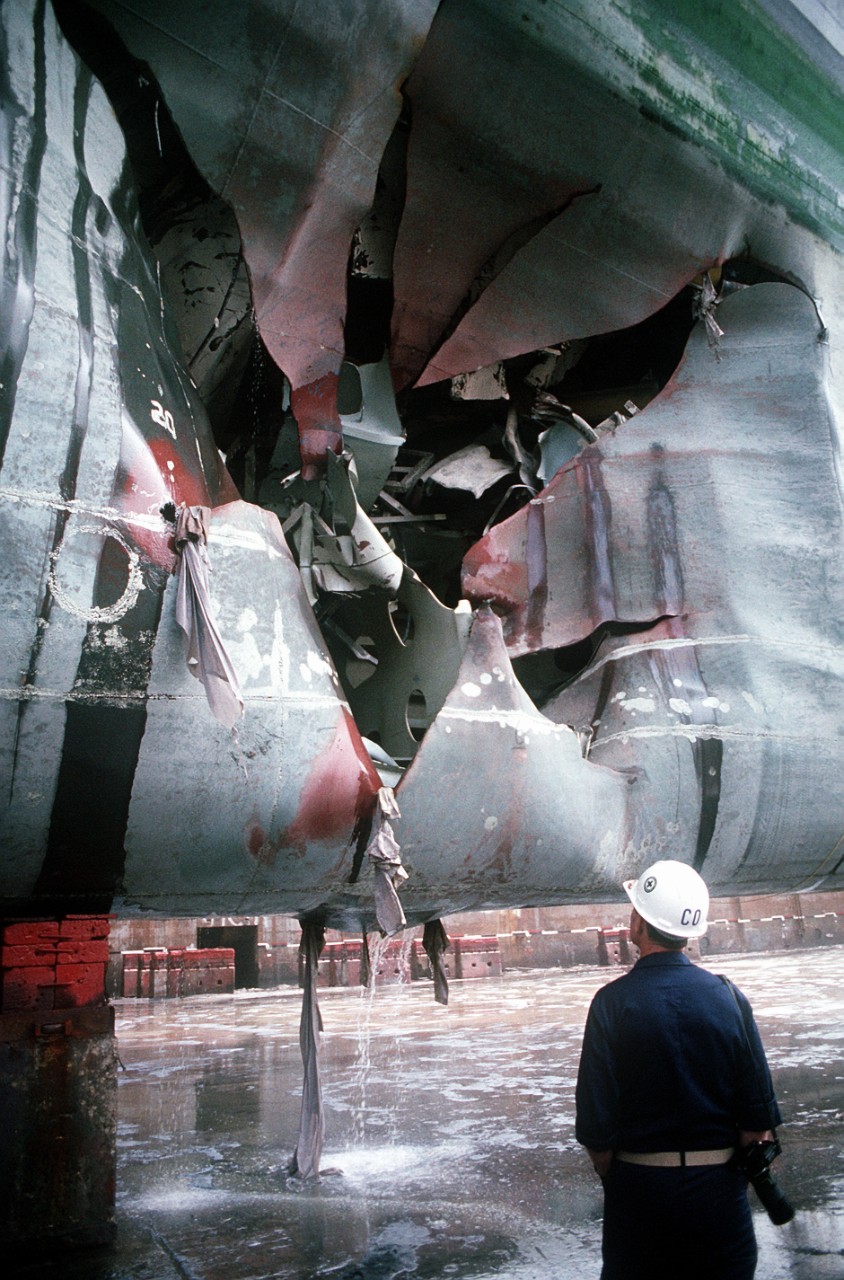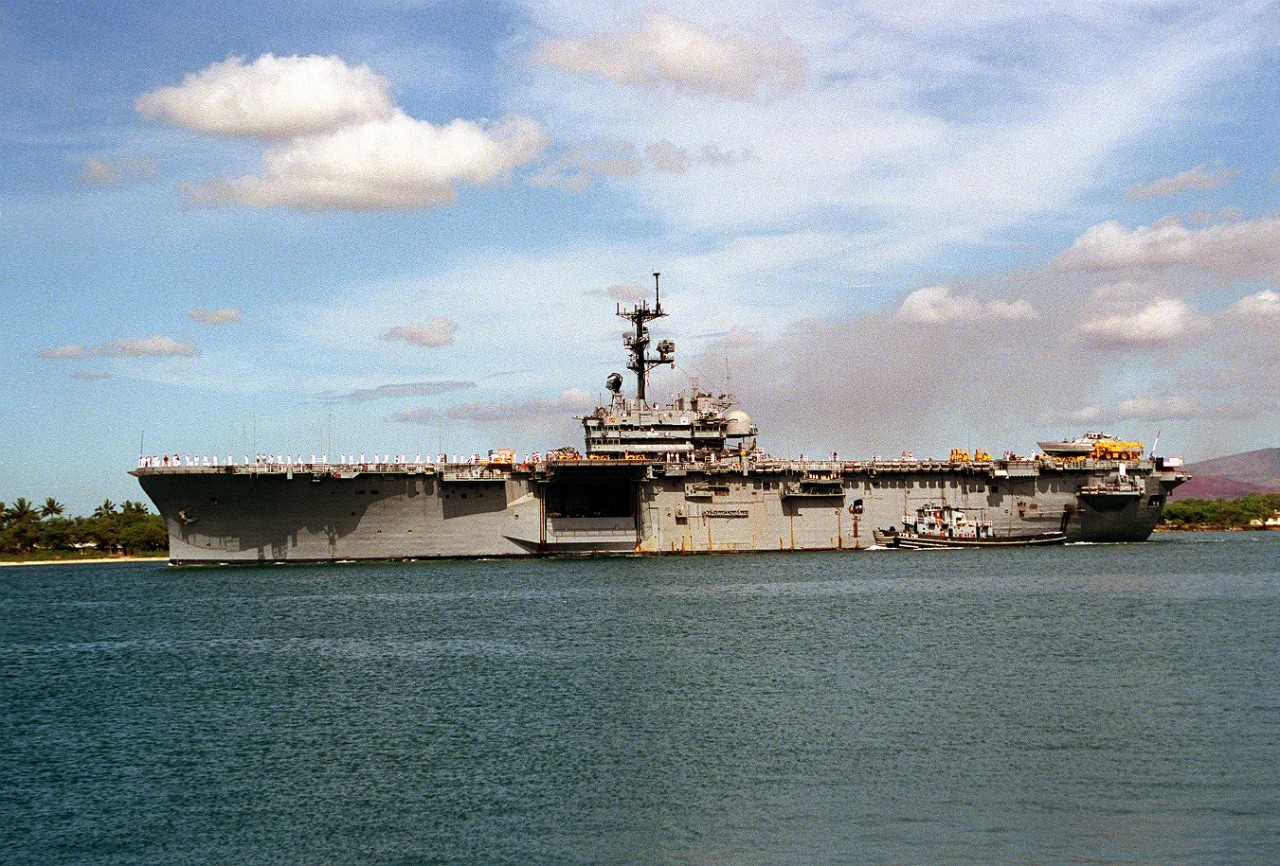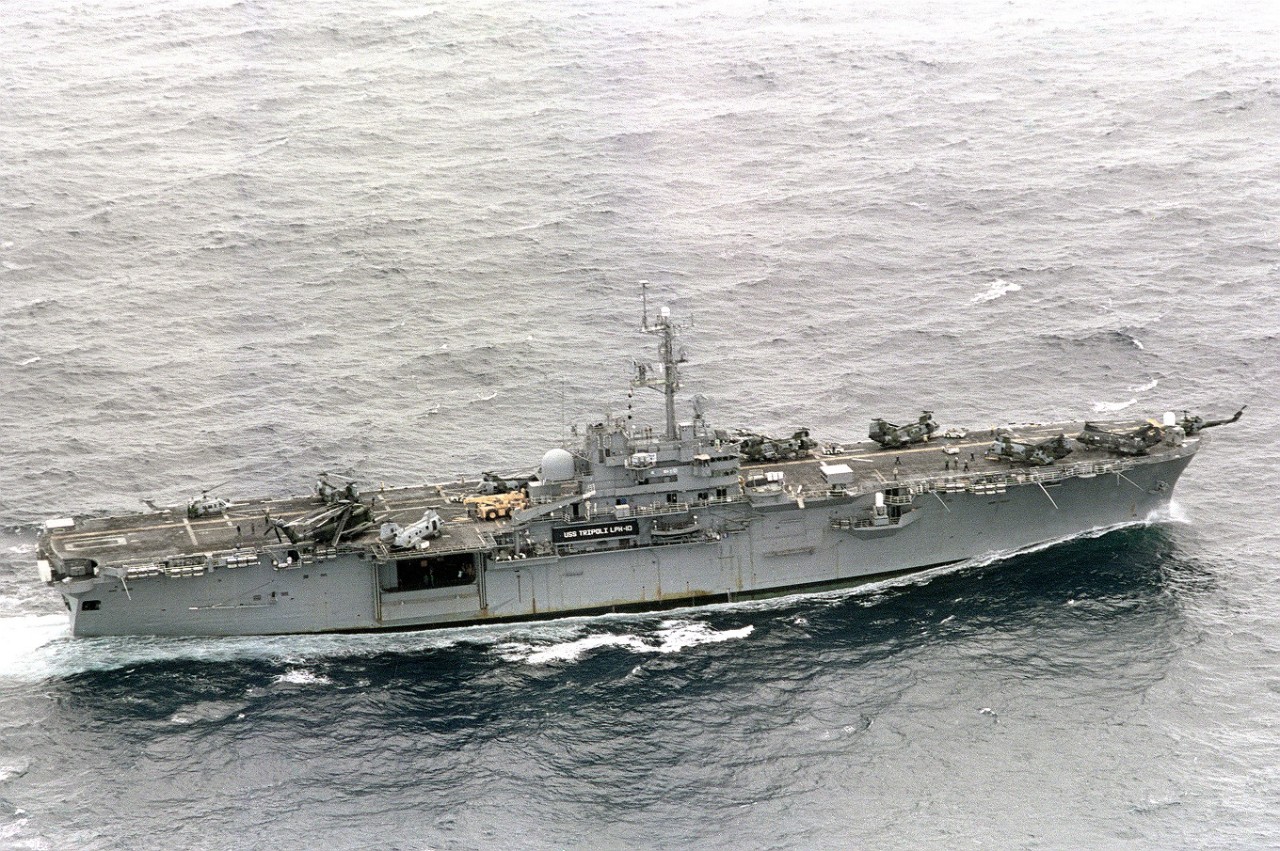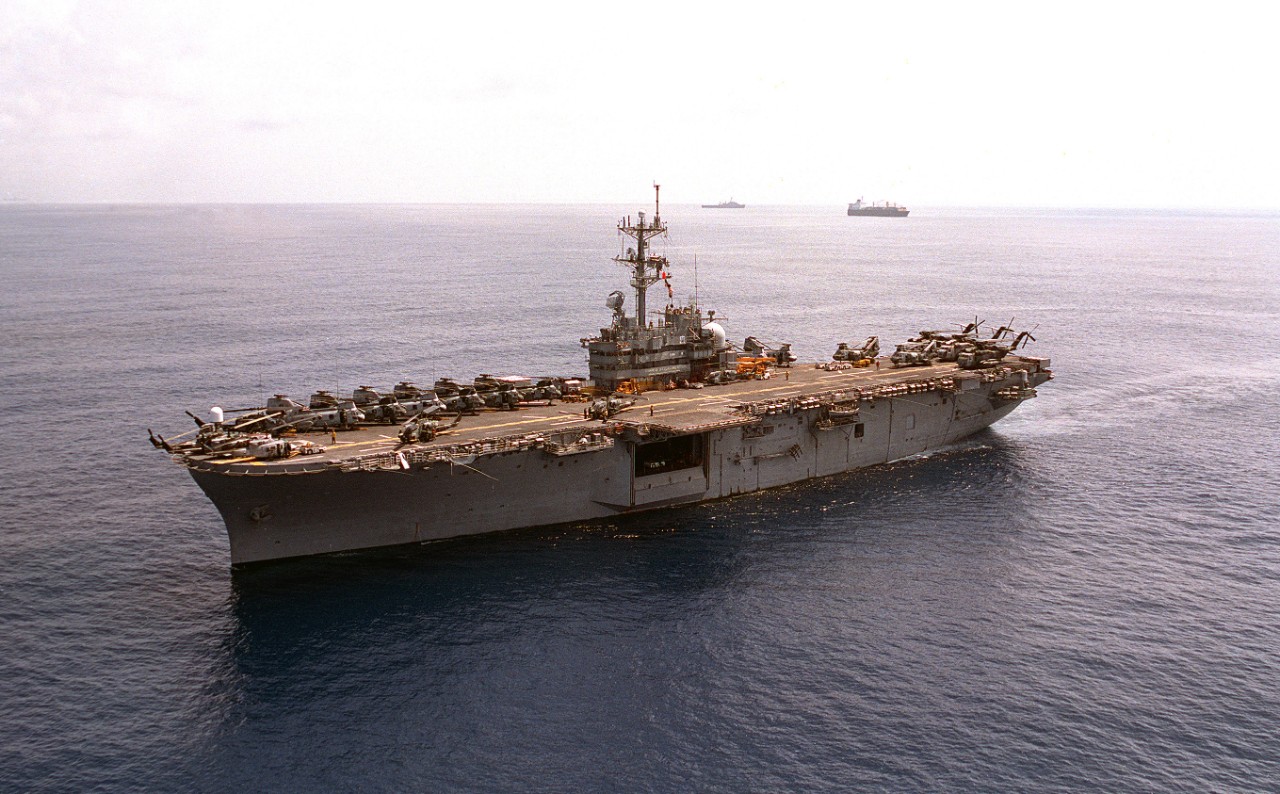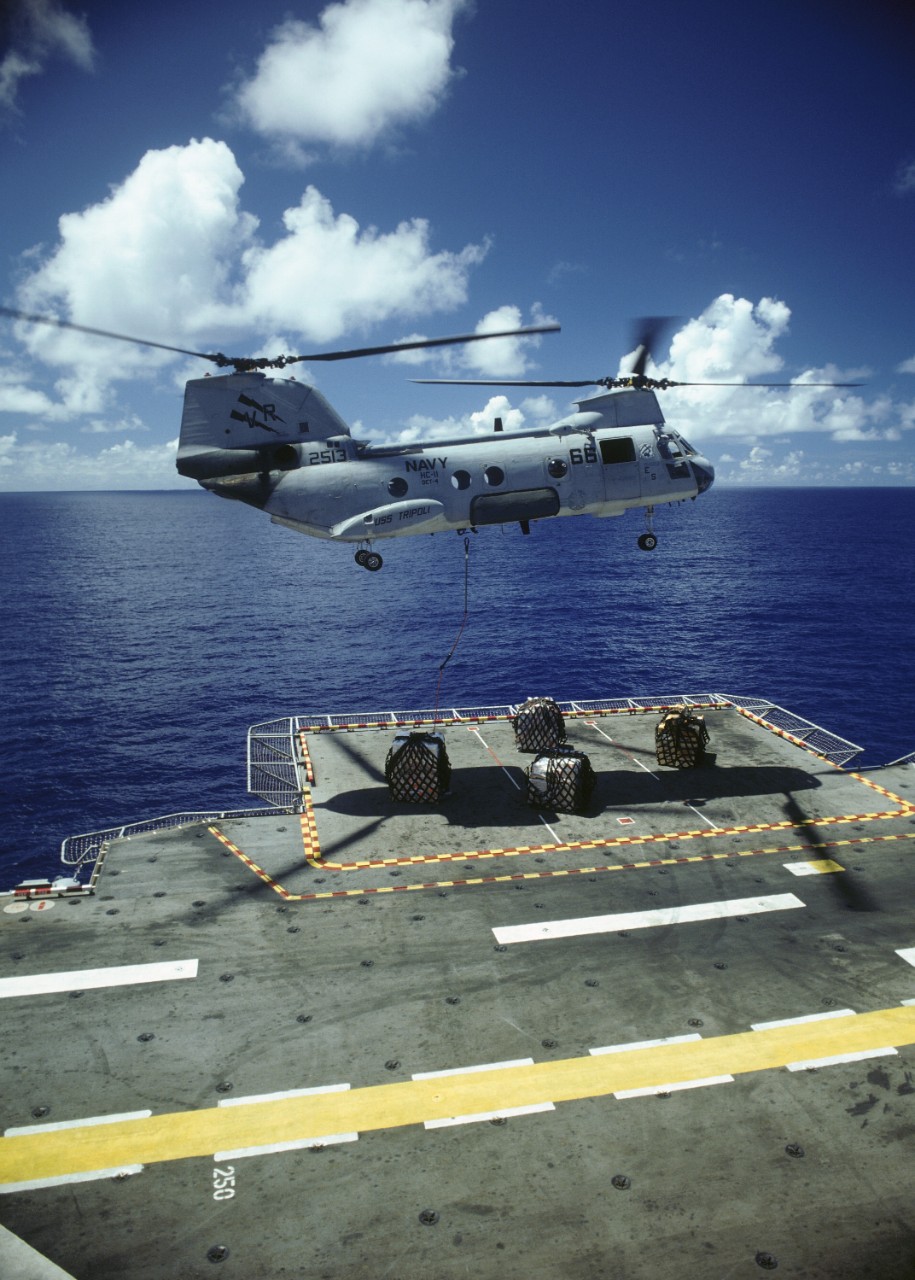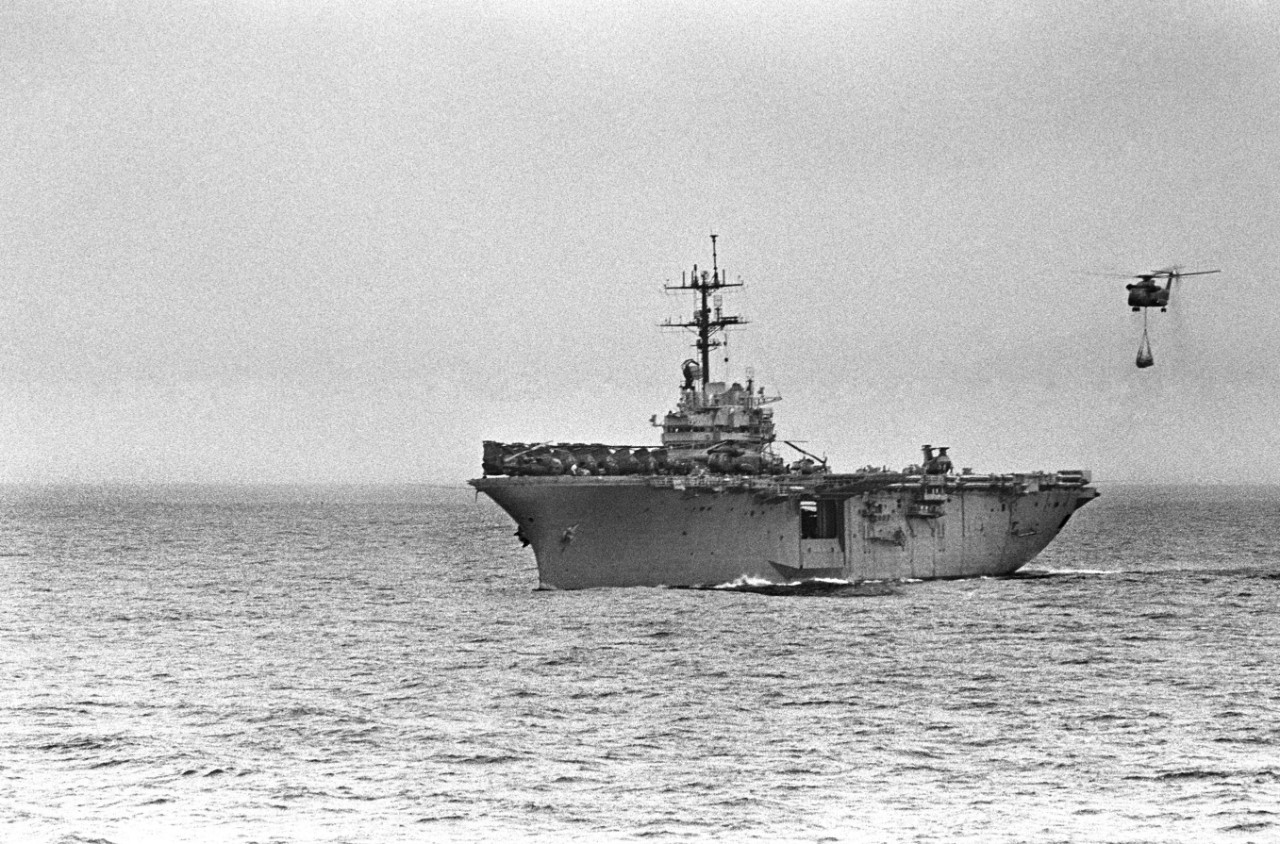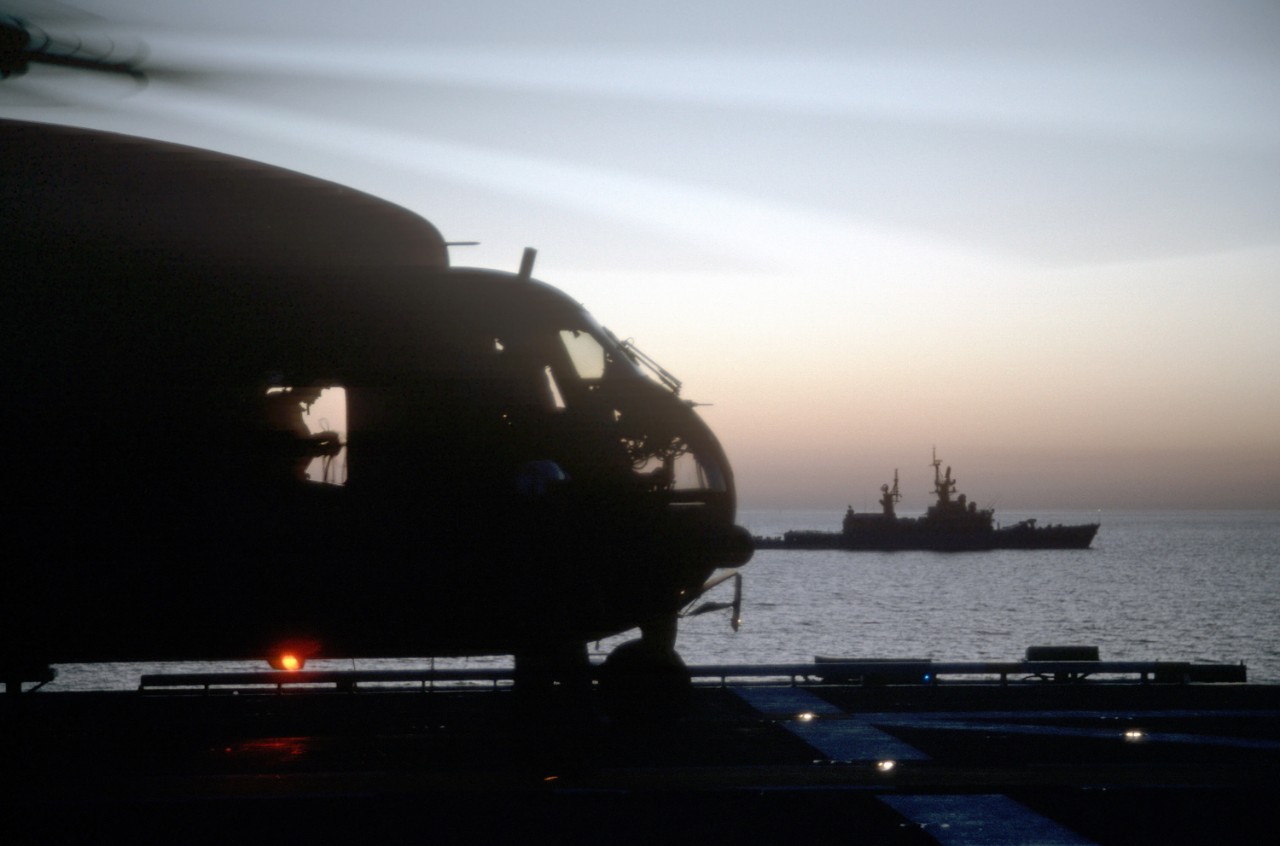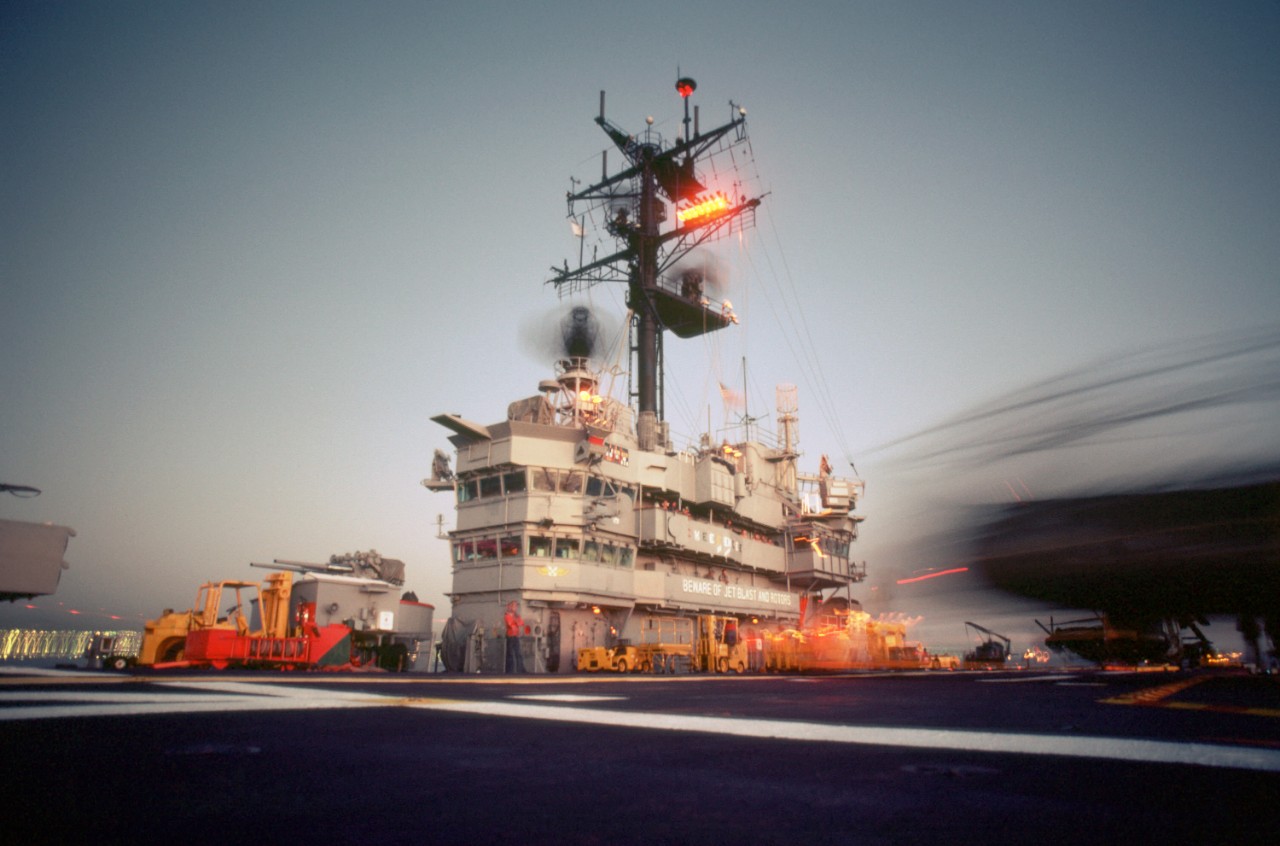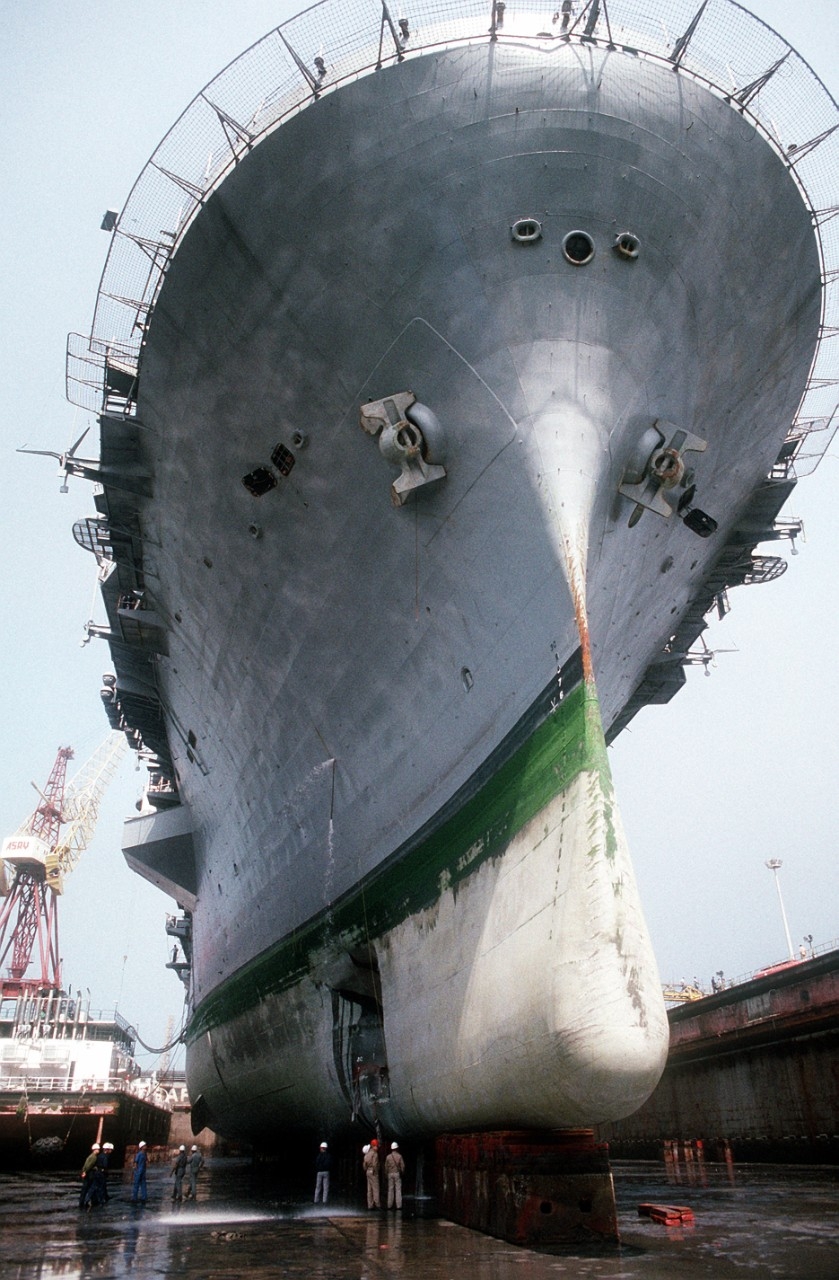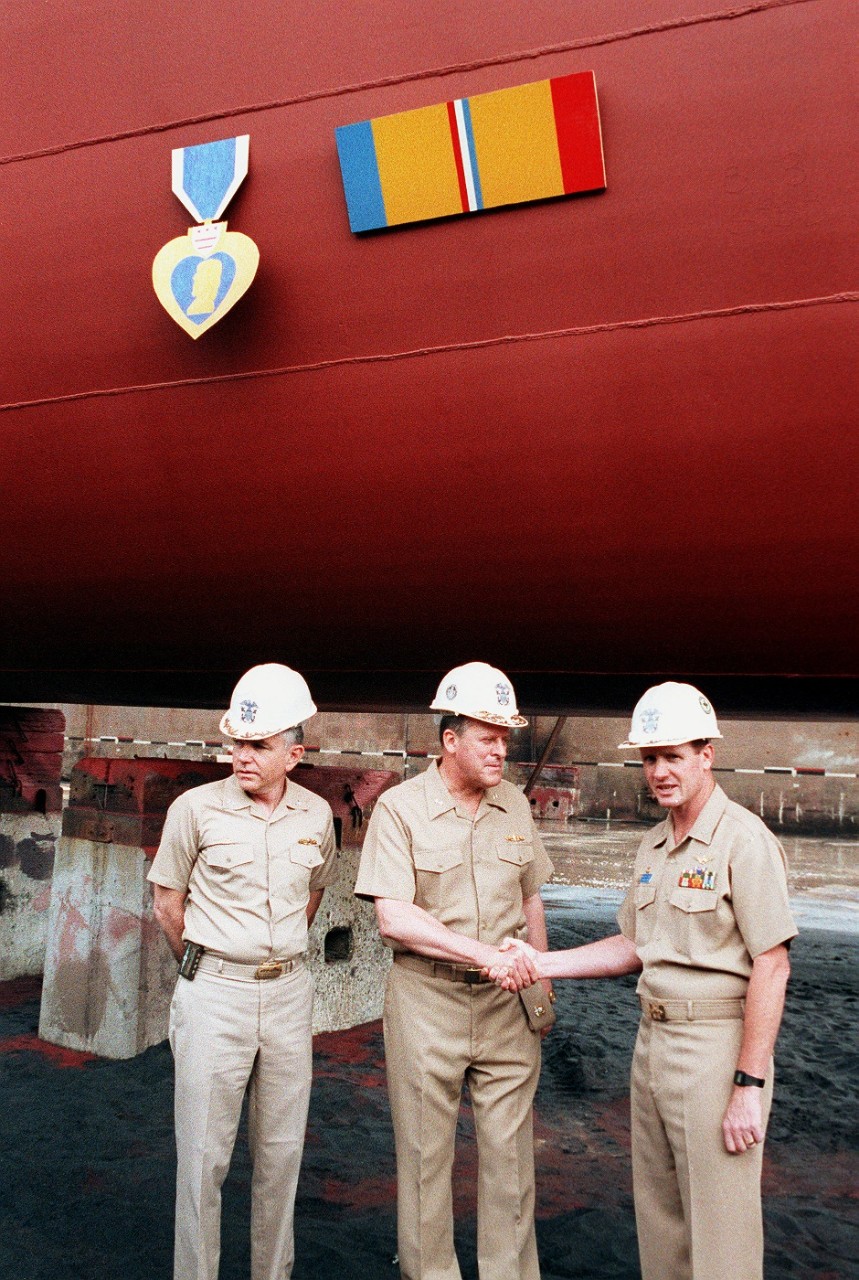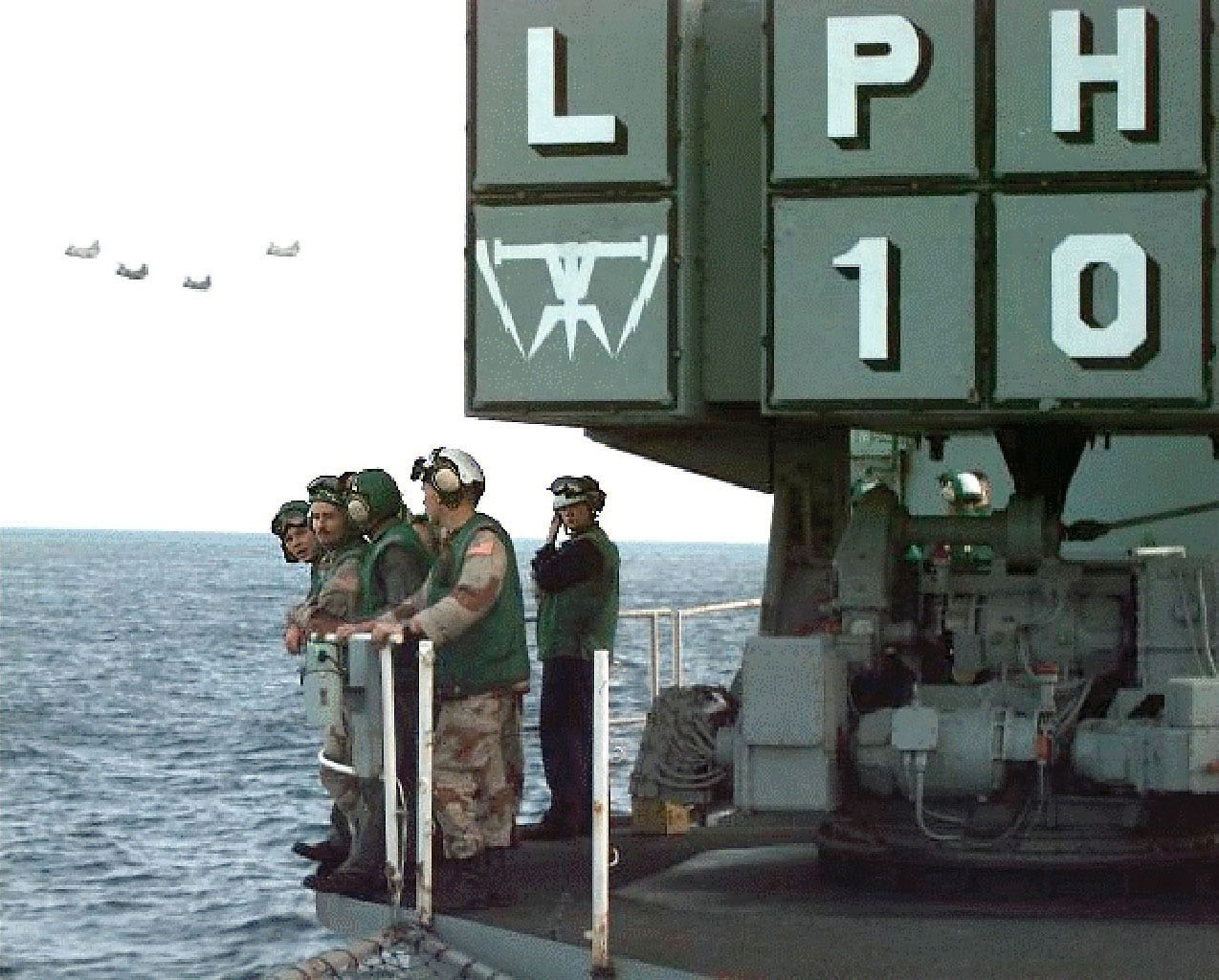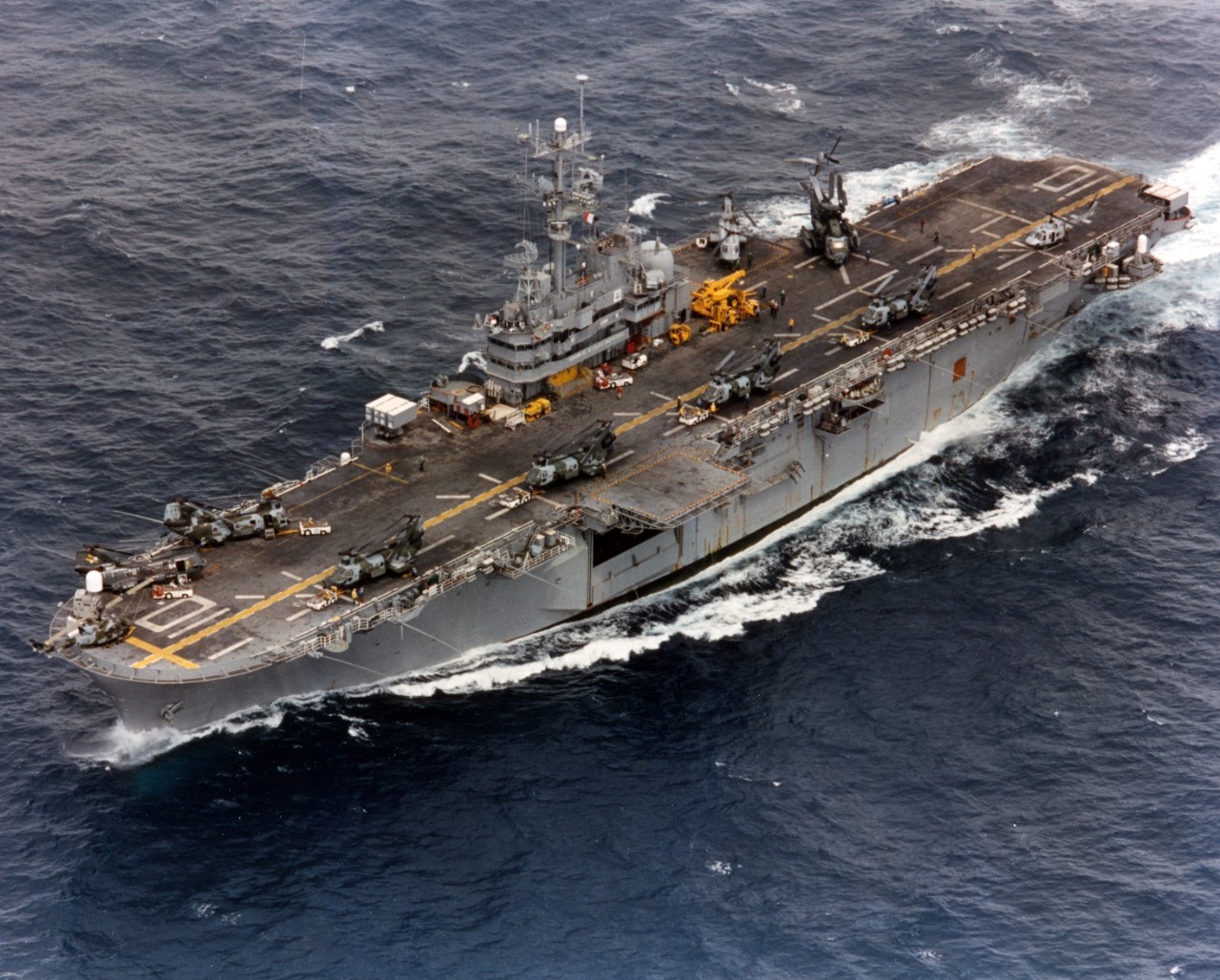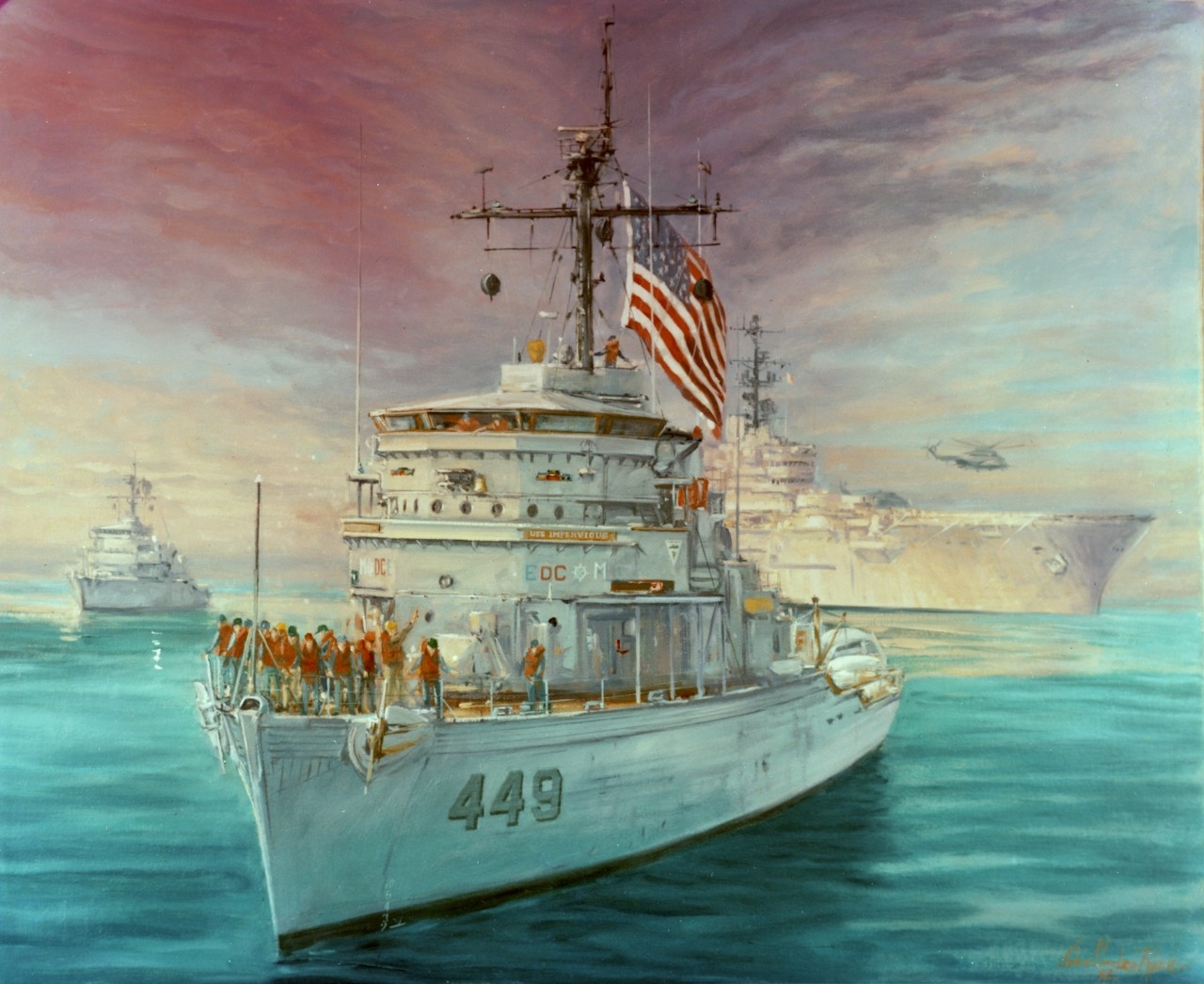USS Tripoli (LPH-10)
USS Tripoli (LPH-10) was commissioned on 6 August 1966 in Philadelphia with Captain Henry Suerstedt, Jr., as the ship's first commander. The Iwo Jima-class amphibious assault ship, used mainly for the deployment and recovery of rotary wing aircraft, was the second U.S. Navy vessel named for the joint land-sea operation against Derna during the war between the United States and the Barbary State of Tripoli. The heroic American victory has been immortalized by the phrase from the Marine Corps hymn, “… to the shores of Tripoli. …”
Following three months of fitting out, Tripoli was underway bound for her homestation at San Diego, California, arriving 22 November. After she embarked Marine Heavy Helicopter Squadron 463, elements of Marine Observation Squadron 6, and some staff members from Amphibious Squadron 8, Tripoli steamed for the western Pacific, arriving off the coast of Vietnam, 22 May 1967. During her first deployment in support of the Vietnam War, Tripoli participated in eight amphibious operations, all conducted along the coast of the northernmost part of South Vietnam. Highlights of the tour included: Operation Beacon Torch where Marines were flown into the vicinity of Hoi An, and they destroyed an enemy force of about 100; Operations Beaver Track/Bear Claw where she steamed off shore providing logistic support, medical evacuation services for casualties, and a platform from which to launch air support missions; and Operation Badger Hunt where Tripoli supported elements of the shore-based 7th Marines in a successful search and destroy operation. On 30 November, Tripoli was relieved as flagship of Task Group 76.5 by USS Valley Forge (LPH-8), and she steamed for her homestation, via Okinawa and Yokosuka, arriving 23 December.
Between late January and the end of March 1968, Tripoli completed a restricted availability at Long Beach, California, and during the following two months, conducted a series of individual ship exercises that included amphibious training. On 12 June, the amphibious assault ship stood out of San Diego on her way to the combat zone. She stopped briefly at Pearl Harbor and at Okinawa before arriving in Subic Bay, 1 July. The following three days, she embarked 2nd Battalion, 7th Marines, Marine Medium Helicopter Squadron 265, Detachment Bravo of Tactical Air Control Squadron 13, and other supporting units of Amphibious Ready Group Bravo. On 6 July, Tripoli departed Subic Bay and arrived off Vietnam the following day.
Tripoli’s second tour in Vietnam waters mostly followed the pattern of the first tour. During the seven-month deployment, the ship patrolled the coast of Vietnam just below the demilitarized zone (DMZ) where she launched her landing contingent quickly whenever they were needed by U.S. and South Vietnamese forces operating ashore. Once again, she participated in eight amphibious operations with the first, Operation Eager Yankee, commencing the day after she arrived off Vietnam. Following naval bombardment, the operation opened with a combined airborne and waterborne assault. Marines charged ashore about 10 miles east of Phu Bai on the coast of the Thua Thien Province. Then, they pressed north toward a known Viet Cong haven, but the enemy avoided contact. On 16 July, Tripoli’s Marines joined other shore-based forces for Operation Houston IV (an operation to reopen and secure Route 1 between Da Nang and Phu Bai) that they participated in until 22 July. They returned to Tripoli the same day; however, the Marines were not on the ship for long. While Tripoli proceeded to the scene of a new operation, just 17 hours after reembarkation, the Marines once again found themselves on helicopters flying ashore to an area about 10 miles southwest of An Hoa, a deep inland in the Quang Nam Province. Their mission during Operation Swift Play was in response to enemy forces making a major thrust toward Da Nang. The landing force remained ashore operating under the 1st Marine Division in defense of Da Nang through November. Meanwhile, Tripoli steamed off shore providing logistics and medical support. On 10 November, Tripoli’s helicopters and landing craft carried troops ashore for Operation Daring Endeavor. During the operation, Marines sought out and destroyed a multitude of enemy fortifications. They concluded the action on 17 November and returned to the ship the same day. Three days later, Tripoli launched another amphibious assault directed at an area in the Quang Nam Province, just south of Da Nang. During Operation Swift Move, initial contact was light and the landing force quickly transferred to the 1st Marine Division for the continued defense of Da Nang against the Viet Cong and North Vietnamese units. Tripoli continued support activities for the landing team.
For the remainder of the tour of duty, Tripoli participated in two more amphibious operations. The first, Operation Bold Mariner, was directed at the Batangan Peninsula of the Quang Ngai Province, where the entire population was considered hostile. The operation aimed to cordon off the peninsula and trap the 300 or so guerillas that were operating there. Tripoli’s landing force would join South Vietnamese troops and American Soldiers in forming the cordon. Navy guns softened the objective areas and Tripoli’s landing force went ashore on 13 January 1969 by helicopters. Tripoli remained off shore providing logistic and medical support during the operation. By 6 February, the troops ashore had thoroughly combed the peninsula and Tripoli’s landing force returned to the ship. The reembarkation of the Marines was just in time for Tripoli to launch her final amphibious operation of the deployment. The expected enemy Tet Offensive required South Vietnamese troops to withdrawal from Operation Taylor Common, then progress near An Hoa in the Quang Nam Province. The landings began at 8 a.m. on 10 February and the offloading of men and equipment continued for several days. Tripoli remained in the area until 16 June providing support. She departed Vietnam that same day and arrived in Subic Bay two days later. There, she turned over her duties to Valley Forge. On 22 June, she was underway for Yokosuka, Japan, for badly needed repairs before continuing on to the United States. She finally arrived back in San Diego on 19 March and began post-deployment standdown.
Following leave and upkeep, Tripoli began an availability period at San Diego until 11 August. After refresher training in September and amphibious training in October, she stood out of San Diego on 1 November poised to return to Far East waters. After a brief stop in Guam to refuel, she continued to Da Nang and arrived on 20 November. During Tripoli’s third deployment to the western Pacific, combat operations off the Vietnamese coast (which characterized her first two deployments) were nonexistent. Instead, she conducted a series of amphibious exercises and operations redeploying homeward-bound Marines. Tripoli continued that cycle until she arrived back at San Diego on 24 June 1970.
For the next 15 months, Tripoli remained on the U.S. West Coast conducting amphibious exercises, refresher training, and preparation for a fourth western Pacific deployment. On 1 October 1971, Tripoli stood out of San Diego bound for the Far East. After stops at Pearl Harbor and Okinawa, she arrived in Subic Bay on 28 October. Early in the deployment, Tripoli conducted more amphibious training and made port visits to places such as Keelung and Kaohsiung in Taiwan and Sasebo, Japan. During her return from Sasebo to Subic Bay, she received orders to deploy to the Indian Ocean with Task Force 74—that was surrounded around USS Enterprise (CVAN-65)—in response to the Indo-Pakistani War that erupted on 3 December. The amphibious assault ship remained in the Indian Ocean and the Bay of Bengal for the remainder of the brief war. On 14 January 1972, Tripoli returned to Subic Bay and resumed training operations and port visits. At the beginning of April, she began operations in Vietnamese waters operating on Yankee Station where she provided search-and-rescue and medical evacuation services. She departed the combat zone twice, once for upkeep at Subic Bay and later to exchange landing teams at Okinawa. At the end of June, she resumed flight operations in connection with troop movements. However, instead of carrying embarked Marines inland for amphibious landings, her helicopters moved Vietnamese troops from point-to-point ashore. On 29 June, Tripoli-assigned helicopters helped transport more than 1,400 Vietnamese marines from Tam My to the vicinity of Quang Tri City during the allied counteroffensive to recapture areas of the I Corps tactical zone that had been overrun by North Vietnamese troops. As the codenamed operation Lam Son 72 progressed, Tripoli remained off shore, evacuating casualties and waiting should reserves be required. The necessity for reserves came shortly before noon on 11 July, when Tripoli’s helicopters helped to insert a reserve Vietnamese marine battalion, picking them up near Route 553 and landing them behind enemy lines, about a mile-and-a-half north-northwest of Quang Tri City. On 20 July, Tripoli departed Vietnamese waters bound for the Philippines where heavy monsoons caused extensive flooding. She reached Subic Bay on 23 July and conducted relief operations until 4 August, at which time she set course for the United States arriving at San Diego, 20 August 1972.
Tripoli remained mostly at San Diego for the remainder of the year and into the first couple of months of 1973. On 6 March, she stood out of San Diego for her fifth deployment to the western Pacific. Although the first two months were plagued by problems with her main propulsion plant, she conducted training to prepare for Operation End Sweep—the removal of U.S. mines from Vietnamese waters. After major issues in negotiations with North Vietnam were resolved, the minesweeping operation commenced, 28 June. Throughout the operation, Tripoli provided a platform for helicopters engaged both in minesweeping operations, logistics, and transport services. The ship participated in the operation until 18 July, and Tripoli departed North Vietnamese waters in company with USS Inchon (LPH-12) and USS Ogden (LPD-5). Four days after her arrival back in Subic Bay, the End Sweep task force was dissolved. For the rest of the deployment, she operated out of Subic Bay before she returned to San Diego on 27 October.
Throughout the remainder of the 1970s, Tripoli made multiple relatively routine deployments to the western Pacific. She also had major work completed on her propulsion system to help increase the ships reliability. In addition, she was towed to the Long Beach Naval Shipyard for the reinstallation of Tripoli’s low pressure turbine. During the 1980s, she continued to conduct normal operations off San Diego, the western Pacific, and Indian Ocean. In 1982–83, the ship was the test platform for the tilt-rotor XV-15 experimental aircraft, the precursor of the V-22 Osprey. In 1987, Tripoli conducted patrols in the Gulf of Oman to safeguard shipping during the Iraq-Iran War.
When the Iraqi army invaded Kuwait on 2 August 1990, the United States deployed a major joint force as part of a multi-nation coalition to stop President Saddam Hussein’s aggression. The U.S. Navy provided sea control and maritime superiority, which paved the way for the introduction of U.S. and allied air and ground forces. Tripoli was once again sent into the combat zone where she assumed the role as flagship of a minesweeping force with six MH-53 minesweeping helicopters embarked. During the night of 18 February 1991, Tripoli was unknowingly steaming in a minefield. At 4:36 a.m., Tripoli struck a moored contact mine. The blast from the mine blew a large hole near the bow, however, fuel and paint fumes that filled forward compartments of the ship did not explode. Fortunately, no one was killed, but four were injured. After nearly 24 hours of damage control, the ship was stabilized and was miraculously able to continue operations, although the damage was more severe than originally anticipated. In a few days, USS Lasalle (AGF-3) took over duties as flagship of the minesweeping force and Tripoli made way to Bahrain to undergo repairs that were completed, 1 April. Chief Damage Controlman Joseph A. Carter and Chief Warrant Officer Van Cavin would later be awarded the Silver Star for their actions in the immediate aftermath of the mine strike on Tripoli.
In December 1992, Tripoli arrived off the coast of Somalia and conducted the first landing of forces in support of Operation Restore Hope. During a night operation on 3 December, Tripoli’s Marines were able to secure the airport and seaports in Mogadishu that had previously been seized by Somali warlords. In late 1994, when Iraq redeployed its forces to the Kuwaiti border, Tripoli was sent as the initial show of force. As other ships arrived in the northern Persian Gulf, Tripoli prepared to conduct amphibious operations in response to any further southward movement by Iraqi forces. Operation Vigilant Warrior ultimately resulted in the withdrawal of Iraqi forces from Kuwait’s border.
Tripoli was finally decommissioned on 8 December 1995 at San Diego. The valiant ship earned nine battle stars for her service during the Vietnam War. Tripoli was also awarded the Combat Action Ribbon following the Iraqi mine strike. The ship received numerous other awards, commendations, and citations over the course of her nearly 30 years of service to the country.
*****
Suggested Reading
- H-Gram 059: Operation Desert Storm in February/March 1991; 50th Anniversary of the Vietnam War
- Writing U.S. Naval Operational History 1980–2010: U.S. Navy Mine Countermeasures in Terror and War
- USS Tripoli (LH-10) Command History Report, 1971
- USS Tripoli (LPH-10) Command History Report, 1972
- Desert Shield/Desert Storm
- Surface Navy
- Naval Aviation
Interviews with USS Tripoli (LPH-10) Crewmembers
Selected Imagery
Salvage and rescue ship USS Beaufort (ATS-2), foreground, amphibious assault ship USS Tripoli (LPH-10), and an unidentified minesweeper at anchor in the Gulf of Oman while they took part in a patrol as part of a multinational force stationed in the region. Their mission was to safeguard shipping during the war between Iraq and Iran, 1 October 1987. National Archives identifier 6485373.
Captain Bruce McEwen, commanding officer of amphibious assault ship USS Tripoli (LPH-10), inspected damage to the vessel as it sat in dry dock awaiting repairs. The damage was inflicted by an Iraqi mine that the ship struck while serving as a mine-clearing platform during Operation Desert Storm, 18 February 1991. National Archives identifier 6477708.
Harbor tug Niantic (YTB-781) pulled alongside amphibious assault ship USS Tripoli (LPH-10) as the ship departed from Naval Station Pearl Harbor, Hawaii, 1 July 1991. Tripoli was en route to its homeport Naval Base San Diego, California, after serving in the Persian Gulf during Operation Desert Shield/Storm. National Archives identifier 6475243.
Navy personnel inspect damage to the hull of amphibious assault ship USS Tripoli (LPH-10) as the vessel sat in drydock awaiting repairs. The damage was inflicted by an Iraqi mine that the ship struck while serving as a mine-clearing platform in the northern Persian Gulf, 18 February 1991. Tripoli was able to continue operations after damage control crews stopped the flooding caused by the explosion. National Archives identifier 6477703.
Rear Admiral Raynor Taylor, commander, Middle East Forces, shook hands with Captain Bruce McEwen, commanding officer of USS Tripoli (LPH-10), during a ceremony in drydock celebrating the vessel's repair, 1 April 1991. Four Sailors were injured when an Iraqi mine ripped a large hole below Tripoli’s waterline as helicopters from the ship conducted minesweeping operations in the Persian Gulf during Operation Desert Storm. National Archives identifier 6465359.

